You are currently browsing the category archive for the ‘KidLit’ category.
by Hoity-Toity Otter (and not Abi Cushman)
A little birdie told me something recently that was otterly preposterous. Apparently there are women who… get this… make funny books for kids.
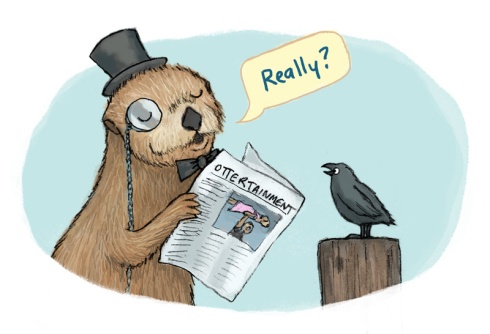
“Really?” I said. “Well this is the first I’ve heard of this and I’ve read many articles about funny kids’ books in major newspapers and magazines, and I don’t recall mention of female authors and illustrators in any of them.”
I continued about my day, chuckling at the very notion. A funny woman?? Who writes for KIDS?? Ho! Ho! Now THAT’S a funny idea for a picture book. For a man to write, of course.
But then something happened. I couldn’t shake this feeling. What if that little birdie was right?? I had to know for sure, so I decided to throw myself into deep research.
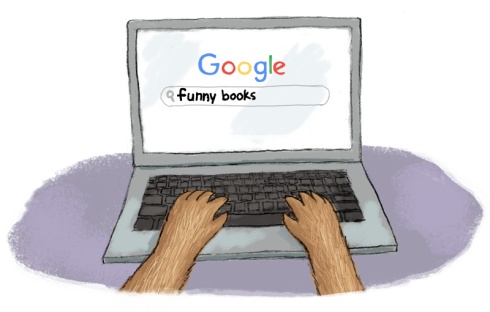
Well wouldn’t you know, there ARE funny female authors and illustrators! Quite a few actually. Dare I say, LOTS. I decided to reach out to some of these creators and gain more insight into this phenomenon. Interestingly, for my first question I got the exact same answer from every single person I asked.
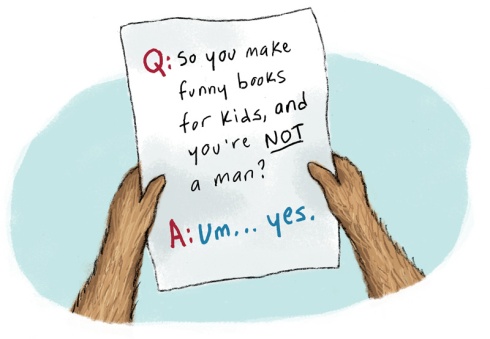
So I felt compelled to dive deeper and learn more about their process for creating really funny books. Here are the results.
- From where do you draw your humor?
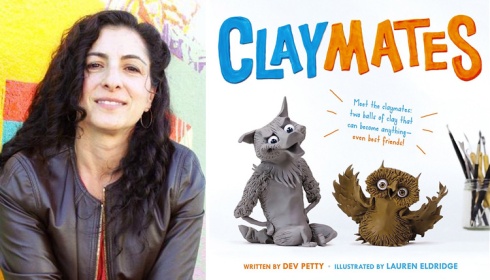
From Dev Petty, author of CLAYMATES:
“Life is funny and occasionally (if not often) somewhat absurd. I draw humor from those uncomfortable and weird bits of absurdity around us and how we humans cope with them. Sometimes I crack jokes when I’m nervous or uncomfortable and that friction, that discomfort, can create a lot of room for humor. I also grew up around a lot of funny, creative people and learned how humor connects people. Basically, if I was entertaining, my family let me stay up late.”
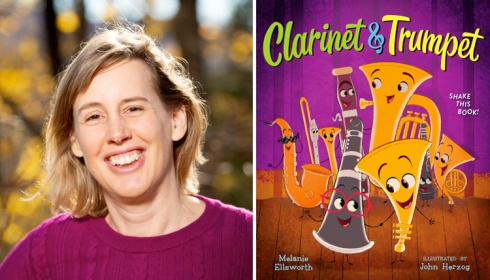
From Melanie Ellsworth, author of CLARINET AND TRUMPET:
“For me, individual words and the way we string certain words together can be very funny. So I’m always on the lookout for a silly turn of phrase – sometimes stolen from my daughter and occasionally something I have misheard. I love playing around with puns and idioms and common expressions and seeing if there’s a story there!”
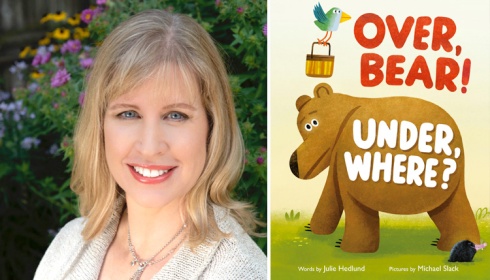
From Julie Hedlund, author of OVER, BEAR! UNDER, WHERE?:
“I get a lot of ideas from movies, comedy shows, books, and even signs and advertisements. When something makes me laugh out loud, I ruminate on WHY it’s funny and brainstorm on how I could make that concept work for kids. I also often get a funny/punny title first and build a story from there.”
- How do you know if your joke will be funny to kids?
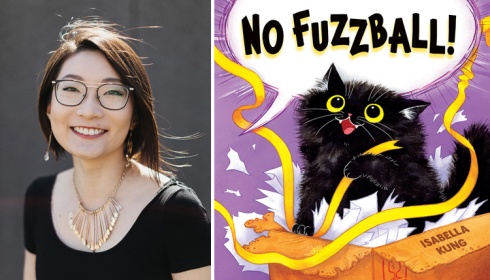
From Isabella Kung, author-illustrator of NO FUZZBALL!:
“First, I would like to acknowledge I am very fortunate that my main character—a cat—is already beloved by many adults and kids. (The internet is obsessed with cat pictures and videos for a reason!) So just getting the character design, attitude, and body language right made a lot of adults and kids laugh. NO FUZZBALL! is very much inspired by my own furbabies, Bubo and Bella. Honestly, I just wrote and illustrated what I found funny and what made me laugh about them. I also drew a lot of inspiration from books and cartoons I loved as a kid. I enjoyed when characters made a mess, and found it hilarious when characters had grand personalities while being completely unaware or misunderstand their surroundings like PINKY AND THE BRAIN. I found that embracing my inner child is the key to writing humor for children.”
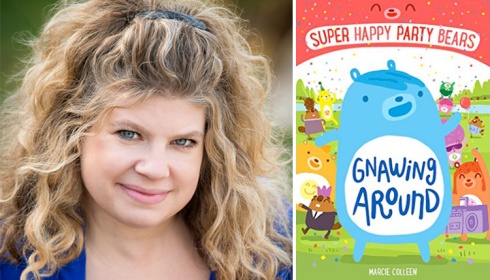
From Marcie Colleen, author of the SUPER HAPPY PARTY BEARS series:
“For me, being attuned to what kids are currently watching in cartoons helps a lot to know what they are laughing at today. When I was writing The Super Happy Party Bears chapter book series my editor asked me to infuse my storytelling with random, absurd humor like in Adventure Time, a popular Cartoon Network show at the time. I sat down and watched several episodes (cool job, right?) and took notes on how jokes were set up, the rhythm of the jokes, and basically the essence of what was considered funny. I was then able to recreate that type of humor when writing my books. Truth is, I’ve never grown up and I LOVE watching kids television. It’s a quick and easy way to see what’s funny to today’s kids. And it’s hella fun.”
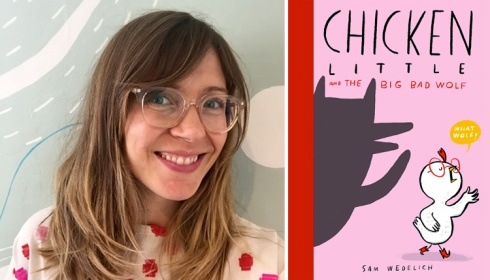
From Sam Wedelich, author-illustrator of CHICKEN LITTLE AND THE BIG BAD WOLF:
“When I’m writing, I try and make myself laugh. That’s the first test. The second test is to read it to kids… I have two kids, so I don’t have to go far, but I also send early drafts or jokes to other friends with kids and get their feedback. Did they laugh? Did they want to hear it again? To me, the highest praise I could ever get on my work is that a kid wants to read it ‘again.’”
- What’s your trick to creating a really funny scene or moment?

From Julie Falatko, author of YOURS IN BOOKS:
“Once I have the story down, I work to shoehorn in as many jokes as I can. I do a revision where all I’m doing is adding as much specific hilarious weirdness as possible. I look at every line and think of how it can either set up a joke or be a joke, and then I make it as silly and weird as I can. Always make it weirder. I have a book with a discarded shoe who likes to sing, one where the main characters wear pizzas on their heads, and one where a dog gives a dramatic speech about a sponge. All those things were added in the “make it weirder” revision.”
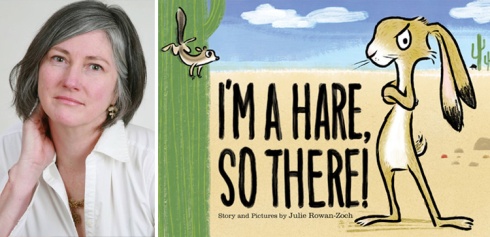
From Julie Rowan-Zoch, author-illustrator of I’M A HARE, SO THERE!:
“More often after I get a drawing or sketch to a point where I am satisfied I take a step back (or hold my iPad further away!) and ask, what can I do that would lift the story – or character look? Especially something that happens to everyone, so viewers can relate, or to evoke an emotion – but something that is not in the text! Add a few lines, move them, or REmove them? A shoe on the wrong foot, perhaps? Gum stuck to it? An eye roll? Maybe with juxtaposition: over-sized ears, a tiny stuffie for a bristly character, an exaggerated mouth wide open on a quiet personality! Would the situation, like a haircut, be more interesting in a kitchen or in a classroom? Unexpected color: purple clouds, mis-matched socks, or green eggs! Even something dark, like a random grimace in a crowd, or a pothole in the character’s path. Or just plain silly, like baby ants in diapers? I suppose it helps having a mind that is always looking for a bit of trouble!”
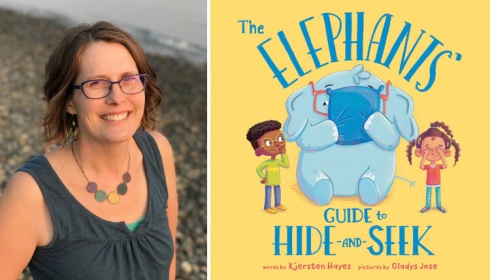
From Kjersten Hayes, author of THE ELEPHANTS’ GUIDE TO HIDE-AND-SEEK:
“My favorite way to create funny scenes is through brainstorming and not stopping with my first idea but pushing myself until I’ve come up with quite a few possibilities. I often set a goal, like I’ll say I need ten different options for how a part will play out and then I’ll brainstorm until I make it to ten. I usually have to get pretty silly to make it that far, which makes things funny. I especially like to use this method to brainstorm how the words and the pictures could show two different points of view or two different parts of the story. Like maybe the character thinks one thing is happening, but reality is a bit different. I also always ask myself after writing a part if this is really the best and funniest possibility I can come up with. I often realize the answer for early drafts is no. Even if I like it, I realize it could be even better. So I try again, and things get funnier. Another small tip—when in doubt, go for drama and exaggeration. Drama and exaggeration are often funny in picture books.”
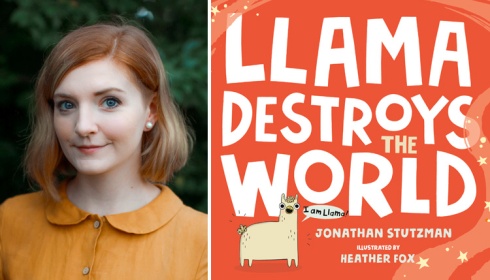
From Heather Fox, illustrator of LLAMA DESTROYS THE WORLD:
“For me, it’s all about facial expressions and body language- specifically the eyes! That being said, you might notice that a lot of my silly book characters have really big eyeballs.This proves useful in scenes that don’t have dialog (and even ones that do!) with conveying a character’s expressions, emotions, and thoughts. Humor often comes from not just a situation, but the reaction of the character in that situation.”
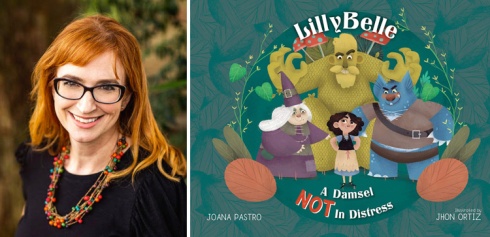
From Joana Pastro, author of LILLYBELLE, A DAMSEL NOT IN DISTRESS:
“My favorite line in LILLYBELLE, A DAMSEL NOT IN DISTRESS belongs to the witch. When she says: “It’s a monstrosity! I love it!” It’s a simple line, but I find it hilarious—especially when read aloud—because she uses the word monstrosity in an unpredictable way, as a compliment. So, when I’m working on a funny story, I always aim for the unexpected by searching for out-of-the-box situations or the unfiltered honesty that young children have. If I want to amp the humor, I will make a list of predictable outcomes and then a list for absurd ones. I love a good twist, a great surprise. That’s what I always aim for.”
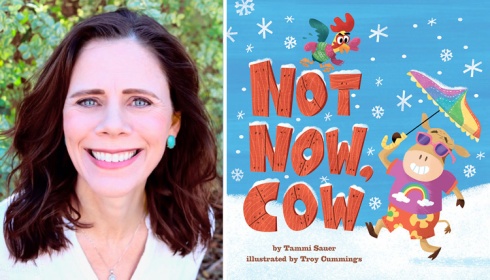
From Tammi Sauer, author of NOT NOW, COW:
“I think every writer has different strengths, and one of mine is humor. Most of what I write just comes out funny. Even so, I don’t settle. When I’m working on a manuscript, I keep toying with each word, each line, and each scene until I get that YESSS feeling. The YESSS feeling usually involves me laughing and crying alone in my office but whatever. It’s the best.”
- What do you do if your editor/agent/art director doesn’t ‘get it’?
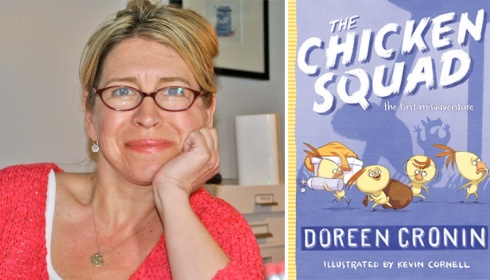
From Doreen Cronin, author of THE CHICKEN SQUAD series:
“Ha! This happens all the time. I can get in a groove where I think everything is funny. When I hear back that I am alone in that — I re-write. It’s like writing any other genre, not everything you think is coming across (humor, emotion, plot) is coming across clearly. Re-write, re-write, re-write. Comedians work out their material in a room with an audience and sharpen it until it really works. Writers do the same. Your audience becomes your agent, editor, art director, etc. (My kids tell me how “not funny” I am all the time!) It’s usually more about sharpening than deleting all together. For every 30 jokes you write, three of them might actually be ready. Rewrite! The punch-line is there, it just might be circling and you haven’t really brought it in for a landing.”
Well to quote Baby’s father in Dirty Dancing, a movie all sea otters love quoting, “When I’m wrong, I say I’m wrong.” I was absolutely bowled over by those responses and give those creators my otter-most respect.
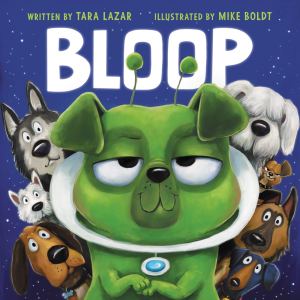 And guess what! It gets even better. I have a special bonus round with the fabulous host of this blog and the author of many funny kids’ books including the upcoming picture book, BLOOP, illustrated by Mike Boldt. It’s the one and only, Tara Lazar! Thank you, Tara, for making my research project extra otterrific.
And guess what! It gets even better. I have a special bonus round with the fabulous host of this blog and the author of many funny kids’ books including the upcoming picture book, BLOOP, illustrated by Mike Boldt. It’s the one and only, Tara Lazar! Thank you, Tara, for making my research project extra otterrific.
So Tara, where do YOU draw your humor from?
My father had a dry wit with zingy one-liners. I grew up with his humor, so it was bound to rub off. We watched funny movies together (his favorite was “My Cousin Vinny”) and he let us stay up late to watch Saturday Night Live. What’s especially funny is that he had a very serious, boring job (at least in my opinion) as a chemical patent attorney. I think his humor provided much needed comic relief at work! But he was obsessed with MAD Magazine as a kid—hiding cut-outs of Alfred E. Neuman all over his house to surprise his parents—so I think he was always funny.
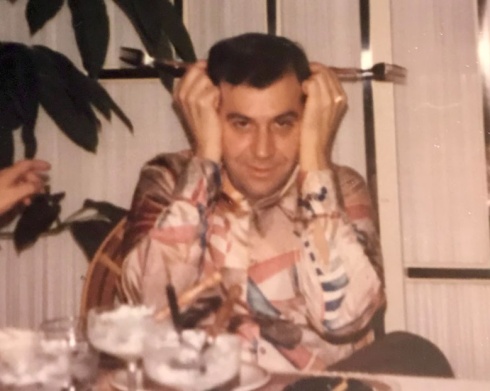
My dad, circa 1979
How do you know if your joke will be funny to kids?
Well, I’m still in second grade, so if I laugh, I’m pretty sure kids will, too. I laugh at silly things my own kids roll their eyes at—but they’re teenagers, so, like, pinch of salt.
What’s your trick to creating a really funny scene or moment?
There’s no trick, really. Humor comes from surprise. Sometimes I’m shocked at what spills out because I wasn’t expecting it, either!
What do you do if your editor/agent/art director doesn’t ‘get it’?
I’m lucky in that my agent does GET IT. But sometimes an editor doesn’t. If they provide comments that resonate and ask for a rewrite, I’ll do it. But those that don’t GET IT just don’t and there’s nothing I can do but move on to the next editor. Humor is subjective.
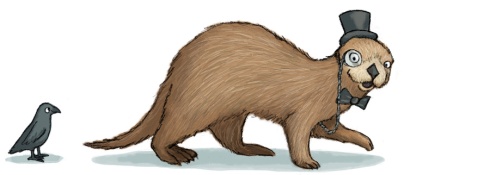
Well, I don’t know about you, but this hoity-toity otter sure learned a lot! And you know what? I just got a wild idea! Maybe someone should tell those newspapers and magazines they’re missing out and should include funny women in their articles! Why hasn’t anyone else thought of this?? I’m going to go do that right now. Ta-ta!
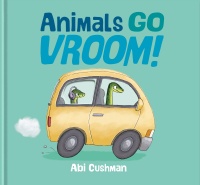 Hoity-Toity Otter is not only the author of this article, he also plays the small but pivotal role of “Taxi Cab Passenger Who Eats a Three-Course Meal While Sitting in Traffic” in the upcoming picture book, ANIMALS GO VROOM!, which rolls onto shelves on July 13, 2021 from Viking Children’s Books.
Hoity-Toity Otter is not only the author of this article, he also plays the small but pivotal role of “Taxi Cab Passenger Who Eats a Three-Course Meal While Sitting in Traffic” in the upcoming picture book, ANIMALS GO VROOM!, which rolls onto shelves on July 13, 2021 from Viking Children’s Books.
 Abi Cushman is the author-illustrator of ANIMALS GO VROOM! and SOAKED!, which was a Kids’ Indie Next Top Ten Pick for Summer 2020. She has also worked as a web designer for over 15 years, and runs two popular websites of her own: MyHouseRabbit.com, a pet rabbit care resource, and AnimalFactGuide.com, which was named a Great Website for Kids by the American Library Association. In her spare time, Abi enjoys running, playing tennis, and eating nachos. (Yes, at the same time.) She lives on the Connecticut shoreline with her husband and two kids.
Abi Cushman is the author-illustrator of ANIMALS GO VROOM! and SOAKED!, which was a Kids’ Indie Next Top Ten Pick for Summer 2020. She has also worked as a web designer for over 15 years, and runs two popular websites of her own: MyHouseRabbit.com, a pet rabbit care resource, and AnimalFactGuide.com, which was named a Great Website for Kids by the American Library Association. In her spare time, Abi enjoys running, playing tennis, and eating nachos. (Yes, at the same time.) She lives on the Connecticut shoreline with her husband and two kids.
If you’d like to learn more about Abi and her books, you can visit her website at AbiCushman.com. For special giveaways, sneak peeks, and more hoity-toity otter musings, subscribe to her newsletter.
Before I recap the SCBWI conferences I’ve attended the last two months, there’s a pressing topic that requires outing…a little quirk I have witnessed at every kidlit conference from the dawn of time (or, in my case, since 2008).
FOMO.
Maybe you don’t have a teen in your household and you’re shrugging right now. What the heck is FOMO?
Well, let’s describe the scene.
See the new-to-kidlit conference attendee, nervous yet determined, marching around the event carrying a stuffed animal based on their story’s character so people will inquire about it, talking to anyone who will listen to the pitch…which, unfortunately, the attendee hasn’t quite figured out yet.
Witness the cornering of an agent or editor in a hallway, a conference room, the buffet line, or heaven forbid, the restroom stall, being asked if they will read the manuscript, listen to the pitch or “peek” at other work.
See the attendee making conversation about the story and only the story, never asking anyone what they’re writing or even about their family, where they scored that awesome vintage dress, what they do for fun, where they’ve traveled, or anything unrelated to WORK.
You see, the new kidlit conference attendee is gripped by FOMO:
FEAR
OF
MISSING
OUT

FOMO makes us jumpy, anxious, pushy and, dare I say it, annoying. The person-with-the-manuscript thinks this conference is THE ONE CHANCE to break through, to get the manuscript not only read, but read and LOVED, contracts thrust forward with gusto. They envision a bidding war breaking out right at lunch table 10, pitting Viking against Sterling, swords thrust forward with gusto.
It’s an unflattering portrait I’ve painted, and I apologize. But you see, I too was afflicted by FOMO. I know it so well because I lived it. (I am the first person above with the stuffed animal, just so you know.)
It took me a couple years, and some serious coaching by professional authors, to calm down at conferences, to realize that the lunch table duel just DOES NOT HAPPEN. Yes, an agent or editor may fall in love with your project, but more frequently they fall in I-think-I-like, ask for revisions, and begin a relationship with you. The opportunities happen AFTER the conference.
And remember, relationships can start with something other than A MANUSCRIPT.
Editors and agents are real people, too. They are not these mystical beings who float away to enchanted realms after a conference ends. They are wives and husbands, fiancés, mothers and fathers, lacrosse coaches, knitters, ukelele players, cycling enthusiasts, City Harvest volunteers, Rick Springfield fans and even former accountants who love spreadsheets (these people mystify me). They are multi-faceted, shimmering personalities. They like to sip a glass of wine at cocktail hour and talk about anything other than the books sitting on their desks. Honestly, an editor will remember the person with whom they share a passion for the Amazon rainforest and try to forget the pleading, desperate person who repeatedly asked if they had five minutes to hear a pitch.
FOMO. It can ruin your judgment. It can make you forget how to forge friendships.
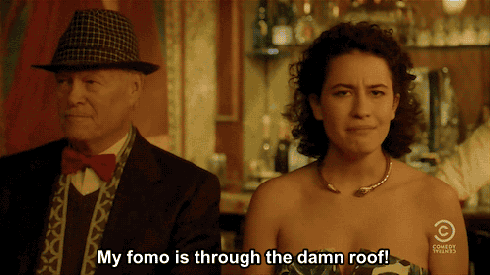
Do not fall victim to conference FOMO. Because if you are clamoring, praying, hoping for JUST ONE book deal, I have to warn you—this is not true! Because once that book deal happens, the satisfaction may indeed last a lifetime, but the longing for a NEW book deal circles back again and you think: JUST ONE MORE book deal. The ideas never end. The storytelling never ends. If you are a writer, a creative being, you are hopefully in this for life. Getting published does not change the mission—to pour your innermost being out on paper. Getting published does not fundamentally change your life (unless you get a 7-figure debut deal). Yes, you have accomplished something few people ever do, you worked hard for it, but you are still you. You will want to do it again. You will want to ride this crazy rollercoaster of rejection and self-doubt and discovery over and over.
So the FOMO you feel? It actually never goes away once you are published. The trick is to learn to control it.

Do not let that BAD FOMO MOJO zap you of your creative energy, your imagination, your unique perspective, your force to do good in the universe. Don’t let FOMO make you a BOZO.

If you are new to kidlit conferences, RELAX. Listen. Learn. Just be you. Don’t fixate on selling the manuscript in your tote bag. Getting published takes years and it is not a race. It’s a marathon, an insanely strenuous yet joyous journey. Sit back and enjoy the run! You are not missing out on anything. You are in the thick of it.
It’s come to my attention that we need a collective noun for children’s book writers and authors.
I am therefore inviting your input.
If you’d like to suggest one for writers and a different one for authors, please feel free. (Can’t forget illustrators!) Leave as many collective nouns as you’d like. Of course, you get points for cleverness. I’ll pull them together in a future post so we can vote on them. And then, perhaps, when we see a gathering of these wonderful folks, we’ll know what to call them.

For those of you who didn’t grow up on 80’s music, this is A Flock of Seagulls.
.
Yes, we’ve gotten to a fourth installment! Or maybe I can call this THE FOURTH STALL?
(P.S. I loved this book. It includes one of my favorite things to write—a secret place that adults don’t know about.)
So, there have been three previous Q&A’s…check them out here: Part I, Part II, Part III.
Without further ado…Part IV!
.
berylreichenberg asks:
If you already have several picture books published, what are the best blogs and other sites to use to get the word out and market your books?
So many kidlit authors tend to stick with promoting on writer blogs, which is certainly good, but we can be preaching to the same audience over and over again. I, myself, worry that people are gonna get sick of me.
Instead, look to librarian blogs, parenting blogs, teacher blogs, homeschool blogs, bookseller blogs and other “gatekeeper” sites that target those who buy children’s books.
Technorati.com is a good place to search for top blogs in various categories, like books, education and parenting.
Some blogs have review policies, so read them and reach out. I receive many unsolicited requests every month. I can’t accept them all, but I do what I can. Bloggers are always in search of good content, so you’ve got nothing to lose by asking for coverage. Make sure you appeal to that blog’s readership with your pitch. (I receive pitches that don’t come close to interesting my audience, which tells me the sender is doing a mass mailing rather than targeting me specifically.)
.
Pat Miller asks:
When you have a drawer full of PiBoIdMo drafts that just don’t seem to get off the ground, how do you maintain your motivation to dig back in and make one of them sing?
Another tough question!
I have barrels full of uncompleted manuscripts. Honestly, I tend to think that if I’m not “feeling” them, they’re not worth my time, at least not at the moment. I might feel them later, so that’s why nothing ever gets tossed.
Jerry Spinelli’s EGGS was in a drawer for 20 years when his wife Eileen made him pull it out. He reread the manuscript and felt re-energized. Neil Gaiman got the idea for THE GRAVEYARD BOOK 20 years before he actually wrote it. He wanted to wait to become a better writer because he knew the idea would be challenging to execute.
Other writers will argue that you cannot wait for the muse, you just have to keep pounding on the manuscript. I tend not to do that because I have enough ideas that do sing to me, in key and on beat.
And hence we get to the reason why I do PiBoIdMo—the more ideas in your file, the more potential manuscripts you’ll have. You can ditch one idea and move onto another. In my experience, the best manuscripts have begun when I have stopped working on a manuscript that’s been giving me headaches. It’s like my brain has suddenly been freed from its chains. My upcoming title, I THOUGHT THIS WAS A BEAR BOOK, came about after I ditched a struggling manuscript. The words for BEAR just flew out, whereas I was laboring hard on the previous story and it just wasn’t working.
Sometimes changing the voice or POV in a manuscript is enough to get it revived.
A critique partner pow-wow can also provide a boost. Just sit around with some best buddies (and coffee and coffee cake) to discuss the challenges and concerns you have. Ask for suggestions and solutions. If you can’t do it in person, Google hangouts are fun, especially since you can stay in your jammies. I truly believe critique partners are not just for completed manuscripts, but those in progress, too.
When all else fails, go for a walk or take a shower. Research shows that “thinking on our feet” leads to creativity. And mundane, repetitive tasks give our minds freedom to wander.
.
Amymariesmith asks:
I’m going to my first SCBWI regional conference in June. Any tips on what to bring?
Have fun, Amy! You should bring:
- A list of your PB ideas. I think it’s great to get a professional’s opinion about whether your story ideas are marketable or if they’re too common and need work. You might have an opportunity to sit down with someone to discuss them.
- Your manuscripts. You never know when a critique opportunity will arise.
- A list of industry questions. I know I tend to forget everything once I arrive at a conference. If there’s something you want to know, write it down and keep it handy. There’s often panel discussions where you can pose your questions.
- A notebook and pen to take good notes. (Then when you go home, type up your notes. This will help them soak into your brain.)
- A camera. Take pics and share them.
- Your business cards. Even if you’re unpublished, you’re still officially a “writer”. You want to connect with professionals and potential critique partners. If you’re having meals there, hand them out to those sitting at your table. Everyone else will remember to hand them out, too!
Side note: sometimes at conferences I’ve seen unpublished writers carrying plush likenesses of characters they’ve created. This seems like a smart idea, to attract attention and questions about your work, but some professionals just think this is strange. Great writing is guaranteed to attract positive attention, not gimmicks.
.
Mrs. Ricefield asks:
I would also love to hear more on how to make the best out of conferences you attend. Thank you for the question.
See my suggestions above on what to bring. Also, make friends. See someone standing alone? They’re an introverted writer, but writers love to talk about writing, so go say hello. This is your opportunity to network and gain a support system. Have fun and be yourself.
Don’t go with too many expectations—it’s rare to get a book deal or an agent at a conference. (But be sure to follow-up if someone expresses interest. Things happen AFTER the event.)
Volunteering at a conference is also a great way to get one-on-one time with professionals and to be remembered. Why not volunteer to pick up agents and editors at the train station or airport? You’ll have time to chat and get to know them.
Ask editors about life outside the office. You’ll connect on a more personal level and you’ll be one of the few people who aren’t trying to squeeze a book deal out of them. Editors are people, too. They get tired of being pitched, poked and prodded.

Great friends at the NJ-SCBWI Annual Conference. Authors Ame Dyckman, Sudipta Bardhan-Quallen and Kami Kinard.
.
Angela Turner asks:
I am writing a nonfiction book in narrative form but I want to put notes on the same page that tell a little more with more specific language. What is the proper way to show this in your manuscript?
While I haven’t written this kind of book before, I suggest using a format similar to how we place art notes in a picture book manuscript. Use brackets to denote the sidebars. Like this: [Sidebar text:].
Maybe someone more experienced with these manuscripts can comment below.
.
Joy Moore asks:
How would you describe your writing style?
A quirky, punny word-a-palooza.
.
Brenda Harris asks:
If an author-illustrator is self-publishing, who are the most important people (editors, art directors, etc) I should ask advice(hire?) from about my dummy book. And- where can I search and find these legit helpers?
There are independent editors with decades of publishing experience whom you could try. Just a few:
Read through each consultant’s site to determine the best fit for your writing style.
Also, be aware of current publishing scams and hustles. There are those who prey on writers with dreams of publication. Check out Preditors & Editors.
Before you begin, you should know the distinction between true self-publishing and publishing via a vanity press. Read this blog post.
.
Thiskidreviewsbooks asks:
I’d really like to know what your best time to write is (and the importance of having a set time to write).
Erik, I don’t have a set time to write. I have found that routine tends to stifle my creativity. I know some writers insist upon writing the same time every day, in the same place, with the same materials, claiming that routine means they write whether or not they’re in the mood. And I suppose that does work nicely for a lot of writers. It doesn’t work nicely for me.
I’ve never been a routine person. Something about my personality always eschews routine. I cannot remember to take a daily vitamin. I don’t wake up the same time every day nor go to sleep at a set hour. I have a tough time eating leftovers.
I like changing things up. Sometimes I write in the morning, sometimes late at night. Different times of day can lend varying moods to my writing. Same as with different places—sometimes I write in bed, sometimes in the kitchen. Occasionally I work on my back deck, at the park or at the library.
And I don’t write every day. That may have to change when I start writing novels and I’ll need to get more words down, but for now, I take writing breaks. Two days on, one day off. Three days on, three days off. One day on, four days off. (GASP!) Again, I change it up a lot. And sometimes these breaks are dictated by family or other obligations.
With this non-routine routine, I’ve had no shortage of creativity, no writer’s block. I’ve got four manuscripts under submission right now and four under construction.
The bottom line is that there’s no “right” thing that works for everyone. It’s totally up to you to find your creative groove. Don’t take anyone else’s advice unless it resonates with you.
.
Charlotte asks:
Why does it seem that there are so many women writing for children, attending SCBWI conferences, posting here, etc., and yet by comparison there seem to be so many successful children’s books by men? Ya know what I mean? Certainly there are tons of successful children’s books by women, but the rations have me baffled. At the last SCBWI conference I attended, women outnumbered men 98-2. Even if there are more children’s books by women authors, the ratio is not 98-2, not even close. So what’s going on? Do men feel more free to write wackier stories? Do women censor their own out-of-the-box impulses? Do editors and agents subconsciously give men more leeway to push the boundaries/break the rules? Do women tend to write more lesson-y stories? Are there just as many men writing and they just don’t show up at conferences? Whaddaya think?
Charlotte, you may want to check out the VIDA Count. VIDA has found a distinct imbalance between the amount of literature by women that’s published and awarded versus that of men. See these articles:
From VIDA’s FAQ:
But don’t women read more? Don’t they buy more books? Don’t they edit these journals [and books] and read slush? And therefore—isn’t this largely the fault of women, as well?
First: sexism pervades our culture, and so it is often unconsciously absorbed/internalized by everyone, including women. Feminism is an act, not a bumper sticker. It requires the constant re-evaluation of one’s assumptions, habits, and biases. By being a part of the system, women are often a part of the problem.
Further, as Sarah Seltzer points out,
“In my experience, the reality may even be worse than the numbers. Women who are allowed to be prominent — and this is not to erase those who do it on their own merit, because their numbers are growing — often don’t challenge the worldview of those who hire them. In fact, given all the anti-feminists like Caitlin Flanagan, Katie Roiphe and Christina Hoff Summers taking prime media real estate, it would seem that for women, reinforcing sexism is a good formula for vaulting ahead.”
~ Sarah Seltzer, Jewish Daily Forward, March 2012, “Byline Bias – and What We Can Do About It.”
.
Stacy Couch asks:
I was wondering about the different stages of birthing a PB. PiBoIdMo does a great job re: brainstorming. Maybe posts about craft would help bring those ideas to life.
- Character-driven picture books: What they are, what makes a character sing.
- Plot: How to plot a PB.
- Plot: Why stakes matter.
- Rule of Three
- Plot and the Rule of Three.
- Different Genres within the PB World (Quiet, Noisy, Character-Driven, Interactive, Etc.)
- External vs. Internal Conflict
- Allowing Room for the Illustrator
Then perhaps a series about critique groups (how to find them, how to set up one), conferences (purpost, intensives, tips) and another querying agents, editors (the importance of etiquette, researching them beforehand).
I’d love to see more craft-related posts, though, since any agent or editor would focus on the work itself.
Great suggestions, Stacy! I’ve covered some of these topics already. Check out:
- The Rule of Threes in Picture Books
- The Rule of Threes for Picture Book Writers (with video evidence)
- Every Day I’m Structurin’ (by Tammi Sauer)
I’ll cover all your suggestions in craft posts soon. Thanks for the input!
.
In closing, thanks to everyone who submitted a question. This was a fun series and I hope to make it a recurring blog feature!
In case you missed it:
Grab your PiBoIdMo mugga joe and let’s get to it, shall we?
mvanhierden asks:
When submitting query letters for picture books, is it standard practice to include a manuscript?
Always follow an individual’s submission guidelines. Some agents/editors don’t ask for a query first because a picture book is a short read. They’ll ask for a cover letter and the manuscript instead. And even though some want the full manuscript, they’ll still ask for a query letter with it. Why? They want to hear how you SELL the story.
Not sure what goes into a query letter? See yesterday’s post.
But everyone is different; pay attention to their guidelines. Guidelines are in place to help an agent/editor work most efficiently, according to their preferences. Therefore, not following guidelines is subject to an immediate, automatic rejection. They just can’t afford the time to read submissions that don’t follow directions.
.
 Anne Bromley asks:
Anne Bromley asks:
I heard recently that one needs at least 3 polished, ready-to-submit picture book stories in order for an agent to take serious interest. Has this been your experience as well?
Yes, this is what I recommend—have at least 3 to 5 picture book manuscripts polished and ready for submission.
An agent will rarely take a writer based upon one picture book manuscript alone. Yes, it happens, but your odds are so much better if you have several ready. Why? If the agent likes your work, they will almost always ask for MORE WORK. An agent wants to ensure that they are a good fit for you, so they want to connect with a body of work, not just one piece. If they like your submission and want to see more but you don’t have anything else, you’ve wasted an opportunity.
More books ready means more books to sell, which is preferable for the agent. If they can’t sell one manuscript, they have another to sub immediately.
But what about an editor? The same holds true. They could like your manuscript but not have the ability to publish it for whatever reason. They may ask for something else. You want to have that something else ready!
And honestly, you become a better writer with each manuscript you complete. So although you might have one ready to submit, wait until you have more because the next manuscript might be the better sell.
.
Patricia Tilton asks:
When do you set aside a MS after many rejections, even though it’s polished, been through editors and you’ve done the revisions and more revisions? Or do you just keep submitting?
Tough question, Patricia! I feel like this is dictated by a gut feeling more than anything else.
I have an agent, so my rejections always include a reason. If I receive compliments and suggestions, then the manuscript is on the right track and we keep submitting. If I receive a lot of similar suggestions for improvement, I take it back and revise.
For those without an agent, if you receive only form rejections without any personal rejections, it’s a signal that perhaps the manuscript needs more work.
It’s not uncommon to hear of manuscripts rejected 20 or more times, so sometimes it’s about just connecting with the right editor at the right time.
If you’ve submitted widely without a bite, I’d recommend putting the manuscript aside and coming back in a few months to see if you can make improvements. Then try another round. Again, some rejections are about timing rather than quality, so a new round of submissions can yield new results.
.
Carrie Brown asks:
We know, as writers, to revise until our very best work is present. Then, we know to send it out to our critique groups and revise some more. Repeat. Repeat again. Etc. Once our work is “the best it can be,” do you think there is a secret numbers formula as to how many subs a manuscript should go through before being shelved? What if, for example, a manuscript goes through a period of requests mixed with personal feedback from agents, and then said changes are made and it goes back out to be met with chirping crickets? Then what? Just like everything in the writing world, I know these questions will be met with subjectivity, as well. But this inquiring mind values your opinion!
Yes, as you’ll see by my answer above, it really is subjective, a gut feeling. I’ve known writers who have submitted 27 times with rejections and the 28th time was the charm. I’ve known writers who have revised a manuscript on and off for nearly 10 years before it was bought.
I suppose my suggestion is to keep plugging away as long as you feel passion and confidence in your work. Again, sometimes it’s about timing more than anything else.
Let’s go to the scenario you proposed—if you’ve made changes that were requested but have only heard crickets in response, I would probably go back to the previous version. When you revise based upon suggestions from one individual, it’s purely being done to meet their specific taste. And if they don’t like it after the changes have been made, it probably wasn’t the right move.
.
Jo Dearden asks:
In your query letter, when it comes to describing your Picture Book, should you include a short paragraph in the style of a jacket blurb, or should it be a straighter description (like a mini, paragraph-long synopsis)? This is assuming you’re sending the whole text to the agent/publisher.
Yes! It’s an excellent idea to write your synopsis in the style of jacket flap material. This kind of paragraph whets the appetite and makes the reader want to dive in. Pick up a bunch of picture books at your library and study the book jackets. Try to emulate them.

Guess what? There’s one final installment coming tomorrow!
And remember, follow-up questions are welcomed.
Jennifer Kirkeby asks:
What do you do to keep yourself motivated? Especially after rejections?
You know how “location, location, location” is real estate’s most important criteria? Well, “new work, new work, new work” is how I keep myself motivated. A new story is always so exciting, isn’t it?

I’ve seen writers try to sell the same manuscript year after year. On one hand, it’s good to be persistent, but on the other hand, you should know when it’s time to move on. Once you’ve finished a manuscript and started submitting, work on something new. Always have your list of ideas ready. Review them. Grab onto whatever resonates and start writing. An editor might not like what you’ve just submitted, but they might like your NEXT project. The more projects you have, the better your odds of becoming published.
Don’t let rejections get you down. Everyone gets them. It’s the nature of our business. I’ve gotten so many now that they’ve lost their sting. I read the rejection, absorb the comments, decide if I agree or disagree, and move on.
Not every manuscript is for every editor—and a rejection doesn’t mean your story’s terrible and it will never find a home. Editors can reject a manuscript because it competes too closely with one of their existing or upcoming books, or because it doesn’t fit with their imprint’s personality and goals. An editor with a bug phobia may stay away from beetle books. An editor might even love your story, but their team isn’t as enthused.
Remember a rejection is not a personal attack. They are rejecting the work you submitted, NOT YOU. YOU are marvelous. YOU are creative. YOU just need to write another story.
.
Yangmommy asks:
Hi! I thoroughly enjoyed your presentation at the MD/DE SCBWI in Maryland last month. It was the highlight of my day (and I still find myself saying, “whhyyy?”)! But I left wondering more about how and when to insert the art notes. In the margins? Within the text (but doesn’t that break up the flow?)? Do you have an example you can showcase on your blog?
An art note can be written in the body of your text, right after the words the art will accompany. I typically put the art note in brackets and italicize the text, like this: [Art: bear tickles alien.]
I’ve also written manuscripts with so many necessary art notes that my agent has submitted them in graph format. This is because the art notes broke up the flow of the story too much, making it difficult to read. The graph format allows an editor to scan through the story easily while still being able to comprehend the illustrations. I explained this in a post here.
.
Tim asks:
I attended a picture book writing conference recently, and the presenter asked for a show of hands of all those who at least occasionally wrote manuscript in rhyme. Nearly every hand in the room went up. And many new rhyming picture books are published each year. Yet aspiring PB writers are told frequently that rhyme is a very tough sell. So I’d love to see a post or two on how to sell rhyming PBs. Not tips on how to write in rhyme–there are lots of resources for that–but on how to SELL it, including the no-nos either in queries or in manuscripts that will stop an editor or agent cold.
Tim, there are no tricks to selling a rhyming manuscript other than making that rhyming manuscript GREAT. (There’s nothing you can say or do to sell a sub-par manuscript.)
Editors see a lot of bad rhyme, which is why they often tell new writers to avoid it. Rhyming manuscripts that don’t sell:
- use common and predictable rhymes,
- feature wonky meter,
- veer off in an unbelievable direction to meet the rhyme scheme,
- use awkward sentence structure to make a rhyme work,
- feature too many near-rhymes, or
- explore an overdone theme.

What’s a GREAT rhyming story? A manuscript whose rhyme scheme is original and whose meter is consistent. A manuscript that features an appealing, marketable hook.
For a picture book, some agents and editors zip right past the cover letter to get to the meat of the manuscript, so I don’t think anything is going stop them cold, unless you’re wildly unprofessional and stuff your envelope full of glitter.
Your query/cover should:
- address the agent/editor by name,
- explain why you are submitting/targeting that editor/agent/imprint,
- compare/contrast your book to existing titles,
- include a brief synopsis,
- offer a short bio (only with information relevant to writing for children), and
- have a polite closing.
It should be one page only.
The manuscript should be double-spaced in a 12 pt serif font, like Times New Roman.
Again, don’t use gimmicks. Good writing and a professional presentation are all you need to attract an agent/editor’s attention.
.
Ginger asks:
What does a picture book look like in written form and do you add picture ideas?
I mentioned the standard format above. Here’s a pic of what the first page of a PB manuscript might look like:

The second and each subsequent page header will include “Name/TITLE” on the left and numerical page number on the right.
Regarding art notes, that really requires its own post! See these previous posts:
The bottom line is that you only include art notes if it’s not clear what’s happening from the text alone. For instance, if your text says “Felix was happy” but he’s really upset, you need an art note so the illustrator doesn’t make him smile.
Write something like: “Felix was happy. [Art: Felix isn’t happy.]” You should not write “Felix was happy. [Art: Felix is stomping his feet, wearing red, waving his arms and sticking his tongue out.]” That’s far too specific and doesn’t leave the illustrator room to interpret Felix and his feelings.
.
You asked for it, you got it, Toyota.

Sorry, no car giveaway here. Not sure you’d want a ’77 yellow hatchback anyway.
What you’ve got are your burning kidlit questions with my answers. Please remember that these are my opinions and not necessarily gospel. (I can’t sing, anyway. Except, apparently, for 70’s car commercial jingles.)
If you have follow-up questions, please leave them in the comments!
Writenit asks:
Is there a better place than Amazon to search to see if the fabulous (at least in my head LOL) idea you came up with has already been done a million times?
Besides Amazon, try searching WorldCat.org, the world’s largest database of library holdings. A simple Google search is also a good idea. Try the various types of Google searches, including images and news.
But just remember, even if your title is taken or your idea has been published, there might be room for your manuscript, too. General ideas can be similar, but the execution can result in wildly differing stories. Of course, if there’s an extremely popular book with your idea, odds are that a publisher won’t take a chance on a directly competing book. In other words, if your dragons love tacos or your crayons are going on strike, you probably want to look elsewhere for ideas.
.
Patricianesbitt asks:
Do you have any inside tips as to what themes or topics publishers are looking for?
This information is always changing. Right now, I hear that character-driven picture books are all the rage.
“Looking for” details can often be found at SCBWI conferences and on blogs when a particular agent or editor has been interviewed. You might want to search for conference bios, where professionals often divulge their wish lists.
You’ll also want to visit the bookstore at least once or twice a month. See what’s being displayed face-out (publishers have paid for this promotional opportunity). Are there are a lot of books on one particular subject, like trucks? Well then, the truck ship has probably sailed. (Whoa, that was a mixed metaphor, huh?) Once you see an abundance of one kind of book in the stores, the end of that craze is probably upon us. Remember pirate books during the Johnny Depp “Pirates of the Caribbean” movies? I went to a conference around that time and the editors practically screamed, “No more pirate books!” Sometimes they know more about what they DON’T want than what they DO.
Bottom line: everyone wants a good story. You don’t have to write to the marketplace’s demands. In fact, I suggest that you don’t. Whatever idea stirs up the most passion in you is the manuscript you should be writing. Your enthusiasm will be evident on the page—and that is always appealing.
And always remember Karma Wilson’s example. McElderry’s sub guidelines said “no rhyme and no talking animals” when she sent them BEAR SNORES ON, which turned out to be a huge hit, launching her successful career. It was a great manuscript, so the DON’T guidelines became moot.

.
Maria Matthews asks:
Is it better to aim at writing a current popular topic or to write a quirky unusual book?
As I noted above, “currently popular” isn’t your best bet, simply because the books released today got purchased as manuscripts two to four years ago, on average. So you can’t necessarily catch up to what’s hot. And what’s hot is always changing. You never know what the next “big thing” will be.
That’s why I suggest writing from your heart. If quirky and unusual is what you enjoy, then by all means, write quirky and unusual!
.
Josh Funk asks:
How do you get awesome illustrators to do “head shots” for you? (like AJ Smith did in your previous post)
When I first began my blog seven years ago, I paid illustrators to do graphics for my site, like this watermelon-themed banner by the talented Val Webb.

Now that my blog has become well-read, I often ask on Facebook or Twitter for a particular graphic and someone volunteers their services, in exchange for a mention and link. I’m usually blown away by the response, and so grateful!
.
Jdewdropsofink asks:
So after reading your previous post, I want to know the super secret story techniques you learned from Sudipta?
I’ve learned a ton from Sudipta. If ever you get a chance to hear her speak or teach a class, grab the opportunity. I’m going to send you to her very pink site instead of spilling her secrets here…
.
Nicole Snitselaar asks:
I would like to know, how much details you must write down when you are planning a PB without words…?
Only as much detail as you need to get the idea across. Be as succinct in your word choices as you are while writing a regular picture book. Paint the overall picture but don’t go into minutiae. You still must leave some things for the illustrator to fill in.
Author Linda Ashman has posted her manuscript for NO DOGS ALLOWED, which is nearly wordless. Check it out here. It’s an excellent example.
.
Tune in for Part II tomorrow, kidlit fans!
On the Facebook PiBoIdMo group, I’ve been asking picture book writers which topics they want to see on my blog. Then it finally dawned on me (and Dawn is my middle name, so this should have occurred far sooner)—I should ask on the blog. DUH.
See that? It’s my head exploding from the geniusity. (Yes, I made that word up. I’m allowed. I write picture books!)
So here I am, asking you, dear blog readers, what is your most burning, brain-blasting kidlit question?
Leave it below in the comments and later this month, I’ll strive to answer them all.
But just remember, you’ll be getting an answer from someone with half a head.
When I was but a wee thing, our family would often drive past a restaurant sign in town: “Good Food and Grog”. So I pestered my parents, “What is GROG?” My father replied, “Grilled frog.”

HORRIFYING! Cooked Kermit!? Envisioning swaths of crisped, green skin beside a sobbing Miss Piggy, I vowed never to eat there.
Well, today I have put that childhood nightmare to bed. I have learned that GROG actually means GROUP BLOG. And, I’ve got a new kidlit grog to share with you.
Welcome author Todd Burleson, GROG spokesperson (who assures me he’s never roasted an amphibian over the coals).
The term GROG evolved out of a desire to gather a group of writers and form a new blog about children’s literature. There are several phenomenal group blogs in the literature world. Many gave us inspiration, but none of them met the specific needs of our group. And, in the spirit of all things creative, we came together to form this GROG.
Our aim with this blog is to provide:
G: Guidance and support
R: Resources on the craft of writing
O: Opportunities to expand our skills
G: Great folks who support readers and writers of all ages!
Each weekday we will be focusing on a specific topic. Here are the daily foci:
Mondays: Mentor Texts
We will look at how mentor texts and other approaches can help teachers and writers of all ages to develop writing skills. We envision doing book reviews here too.
Tuesdays: Tools & Technology
We’ll look at tools, often technological, that can help us as writers.
Wednesdays: Craft
We’ll focus on the craft of writing. Sometimes it will be a writing lesson, other times it might be a review of a book on writing.
Thursdays: Submissions
On Thursday’s we’ll focus our thoughts on submissions, contests, query letters and more.
Fridays: Finds
These will be a smattering of awesome discoveries that we want to share with you.
Now why start a group blog instead of just an individual one?
- Being practical, we knew that sharing the load would help us remain faithful to posting while also maintaining our writing, teaching, family lives.
- We believe that the power of the group is to harness our connections.
- We know that each of us has a specific passion. By harnessing the power of the group, we get to share many more ideas and hopefully will reach and benefit many others.
- We enjoy being together. When we chat or meet via Google Hangouts, the ideas and passions flow.
- Finally, its a way to make the world ‘smaller.’ We have group members all over North American and even one in Seoul, South Korea. We may not be in the same time zone, but we all are dedicated to supporting one another as GROGgers and reaching a larger audience.
We have some phenomenal contributors at all stages of publication, but all eager to share. They are: Jan Godown Annino, Marcie Flinchum Atkins, Todd Burleson,
Tina Wheatcraft Cho, Kathy Halsey, Suzy Leopold, Christy Mihaly, Janie Reinart, Sherri Jones Rivers, Patricia Toht, Leslie Colin Tribble, Pam Vaughan and
Jackie Wellington.
Thanks, Todd! And good luck to you all!
So please go visit these fine folks at Groggorg.blogspot.com.
They will be giving away a boatload of prizes in the beginning of April, including a signed copy of THE MONSTORE by yours truly. You can also like their Facebook page and follow them on Twitter.
Kermit will thank you.
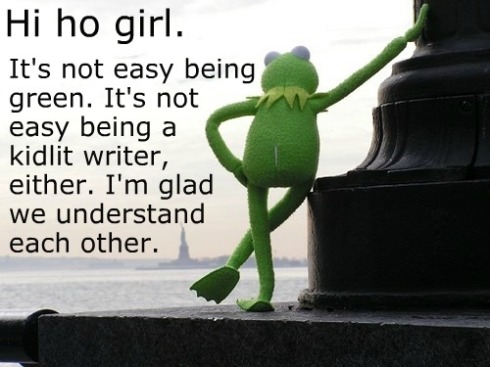
 This week I’m doing something special–bringing you a boatload of notes from Florida’s recent SCBWI conference in Miami, courtesy of author Mindy Alyse Weiss. Why a boatload? Well, it’s freezing here in NJ, so I imagined Mindy on a catamaran, sipping a piña colada with the captain as she wrote this. (We all have dreams, and my dream is to attend a WARM conference! Or maybe that should be a HOT conference?)
This week I’m doing something special–bringing you a boatload of notes from Florida’s recent SCBWI conference in Miami, courtesy of author Mindy Alyse Weiss. Why a boatload? Well, it’s freezing here in NJ, so I imagined Mindy on a catamaran, sipping a piña colada with the captain as she wrote this. (We all have dreams, and my dream is to attend a WARM conference! Or maybe that should be a HOT conference?)
I was thrilled when Tara asked me to blog about the 2014 SCBWI FL Regional Conference in Miami. She always gives so much to the kidlit community through her yearly PiBoIdMo challenge and thoughtful blog posts, and I hope this will help all of you, too. Since workshops are often repeated, I can’t share all the secrets…but I definitely have some juicy info, plus insight into what some agents and editors are hoping to find…
I attended the Agent Panel with Jen Rofé of Andrea Brown Literary Agency, Deborah Warren of East*West Literary Agency and Ammi-Joan Paquette of Erin Murphy Literary Agency, where they shared wish lists and do’s/don’ts with aspiring authors.
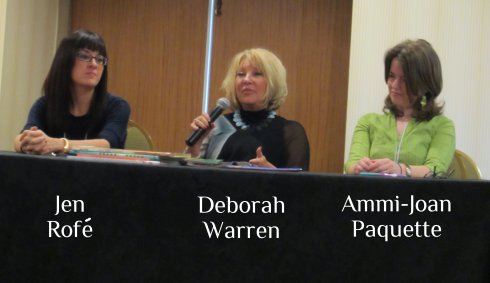
Jen Rofé
- When sending a query, make it clear you’re personalizing it to that agent.
- When asked how many editors she sends a manuscript to at a time and when she considers giving up, she said she won’t stop until she’s exhausted every opportunity.
- The fastest she sold a manuscript—three hours! The longest it took was four years.
- Wish list: commercial character-based picture books. A country song book for YA. Books based on childhood, like a girl who is getting into stuff she isn’t supposed to do, but nobody would expect that.
- If you write picture books, she would want at least four she could try to sell right away.
- Write the thing that scares you. It usually comes from some raw, painful place and that’s where the good stuff comes out.
- So many people say that it only takes one yes. But it’s not just one yes—you typically need lots of yeses, including the editor, publisher, marketing, etc.
- Don’t EVER write to the market!
- A personal note from an agent is a good sign! They don’t have time to send that to everyone. It might be the project/first page/query letter that isn’t quite right at the moment.
Deborah Warren
- Specializes in picture books. She’s known for building brands and loves finding new talent!
- She loves working with author/illustrators—it’s her sweet spot. She’s having trouble with chapter books (they’re usually franchises). Realistic fiction is really coming back and she’s excited about that.
- The client/agent relationship is like a marriage. She’ll never give up on a client—once you’re on the team, you’re there!
- Wish list: Author/illustrators, multicultural, books based on childhood, a book about singing, or kids overcoming their obstacles.
Ammi-Joan Paquette
- She looks for a strong opening in the sample pages and is especially drawn to precise pitches in a query that are snappy and compelling.
- She usually takes three to four weeks to respond to queries. For longer requested manuscripts it was two months, but she’s backlogged right now.
- When working on promotion, authenticity and what feels natural to you is important. An awkward presence is actually worse than no presence. In the pre-published stage, the focus should be on craft.
- Wish list: books that do something really different, a different narrative structure, different POV. She loves unusual projects, books based on childhood—travel, unusual vacations, anything to do with food or baking or French food.
Thanks for the agent tips, Mindy. See you back here on Wednesday with more from the SCBWI FL Conference!
Mindy Alyse Weiss writes humorous middle-grade novels with heart and quirky picture books. She’s constantly inspired by her two daughters, an adventurous Bullmasador adopted from The Humane Society, and an adorable Beagle/Pointer mix who was rescued from the Everglades. Visit Mindy’s Twitter, Facebook, or blog to read more about her writing life, conference experiences, and writing tips.





















